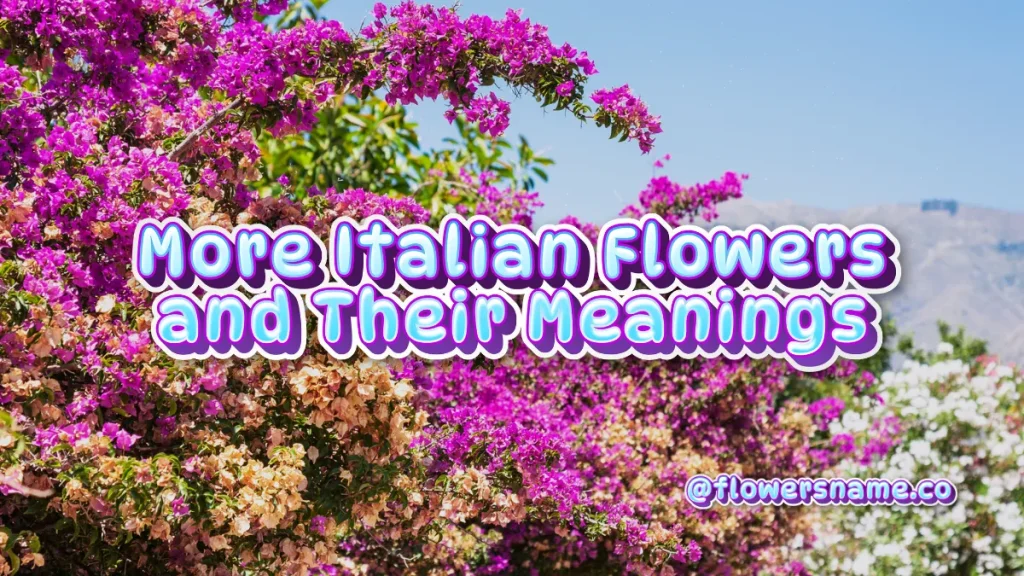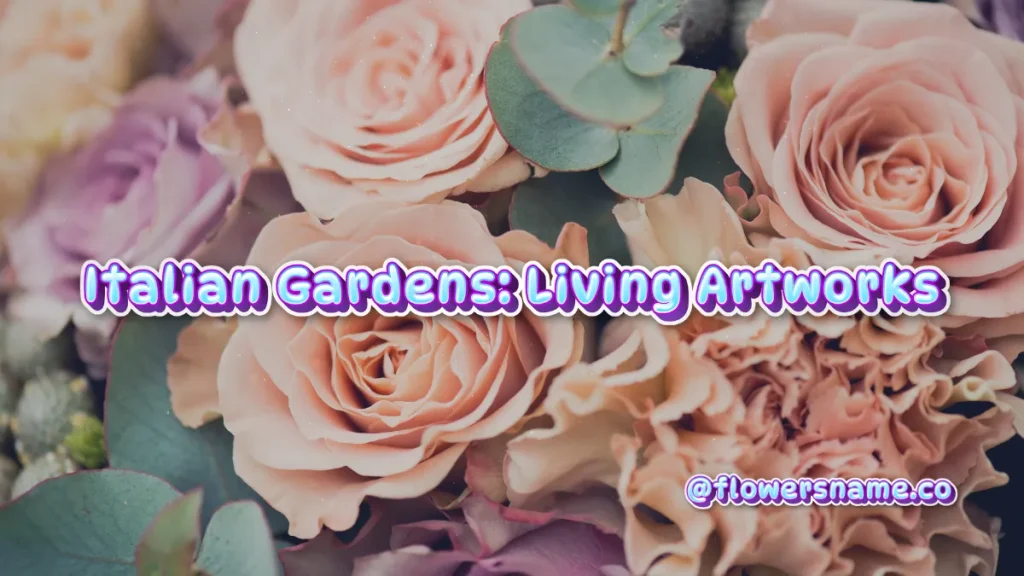Introducing Italian flowers Names, Meanings, Culture & More
Introduction
I remember strolling through a small Italian town one summer, winding through a charming garden brimming with vibrant Italian flowers. The air was thick with the sweet scent of roses, and the sight of wildflowers dancing in the Mediterranean breeze was mesmerizing. You could feel the connection between these blooms and the Italian culture as if each flower had its own story.

Italy has always been intertwined with nature, from its rolling landscapes to the beautiful gardens scattered throughout the country. Flowers in Italy are more than just decorations; they are symbols of love, gratitude, and beauty. Many of the world’s most beloved flowers trace their roots back to the gardens of Italy, where they have flourished for centuries.
In this article, we’ll explore Italian flowers and their significance, uncovering their meanings and roles in Italian culture. We’ll also dive into Italy’s national flower, iconic blooms like lilies, and the history behind these magnificent species. Whether you’re a flower enthusiast or just curious about Italy’s rich floral heritage, this journey through Italy’s gardens will leave you inspired.
The National Flower of Italy: White Lily

Italy, with its rich culture, art, and food that makes you want to stay forever, has a national flower as classy as the country itself—the white lily (Lilium candidum). If you’ve ever seen this delicate beauty, you probably noticed it’s not just any flower. It’s often linked to religious symbols, particularly the Virgin Mary, representing purity and devotion. You’ll spot it during Easter celebrations, adding a peaceful vibe to the occasion, and reminding everyone of rebirth and fresh starts.
But hold up—it’s not all about church and tradition. The white lily is also a symbol of elegance. Its pure white petals, soft but striking, pop up in gardens, parks, and flower arrangements all over Italy. Think of it like the Italian version of Audrey Hepburn—timeless, beautiful, and effortlessly chic. Whether you’re strolling through a bustling city or relaxing in a quiet village, there’s a good chance you’ll catch a glimpse of these graceful blooms. And hey, if you’re exploring flower names, you might want to take a peek at Flower Names for Boys—you’d be surprised at how many floral options work perfectly!
More Italian Flowers and Their Meanings

While the white lily gets the spotlight, Italy’s flower game is seriously strong. There’s a whole bouquet of blooms here, and each one has its own story to tell. Let’s dive into a few that add color and meaning to Italy’s already stunning landscapes:
- Red Poppies (Papavero): You know those fields of red poppies you see in movies set in Italy? Yeah, they’re just as breathtaking in real life. These fiery red flowers aren’t just pretty—they’ve got depth. Red poppies are symbols of sacrifice, often tied to remembering those lost in war. But they’ve also got a softer side, representing peace, sleep, and even death. Something is calming about seeing them sway in the breeze as if nature itself is taking a deep breath.
- Sunflowers (Girasole): If you’ve ever visited Tuscany, you know how these bright yellow giants are on the landscape. Sunflowers are the ultimate symbol of warmth and loyalty—they turn toward the sun throughout the day. They’re like nature’s reminder to always look on the bright side (and who can argue with that?). When you see a field of sunflowers in full bloom, it’s like Italy is wrapping you up in a big, sunny hug.
- Cyclamen (Ciclamino): Now, this one’s a little more low-key but no less meaningful. The cyclamen symbolizes sincere feelings and tenderness. With its heart-shaped leaves and delicate flowers ranging from soft pink to deep red, this bloom is the perfect way to send a subtle, romantic message. Cyclamens are like love notes from nature—quiet but full of meaning.
- Iris (Iris germanica): Talk about regal! The iris has been around for centuries and is often associated with royalty, wisdom, and valor. You’ll see these vibrant purple flowers popping up in Renaissance art and old Italian gardens, bringing a splash of history and class. They’re like the floral version of Italy itself—proud, elegant, and full of stories.
- Lavender (Lavanda): Ah, lavender—the queen of calm. You can’t talk about Italian flowers without mentioning the soothing fields of lavender that stretch across Tuscany and Liguria. Besides smelling amazing, lavender symbolizes relaxation and healing. Whether you’re walking through a lavender field or just catching its scent on the breeze, it feels like the world is slowing down for a second, giving you a chance to breathe.
- Violets (Viola): These little guys might be small, but they’ve got some big meanings behind them. Violets are all about modesty and humility, with their soft purple and blue hues adding a touch of sweetness to Italian gardens. They’re like the quiet friend who doesn’t say much but makes the whole group better just by being there.
Italian Gardens: Living Artworks

Italy doesn’t just grow flowers—it turns them into art. The country is home to some of the most breathtaking gardens in the world, blending nature with human creativity in a way that’ll make you feel like you’ve stepped into a painting. Whether it’s Renaissance wonders or modern-day marvels, these gardens are places where flowers and design come together in perfect harmony.
Boboli Gardens (Florence): Picture this: manicured lawns, intricate sculptures, and vibrant flowers all in one spot. That’s Boboli Gardens for you. Dating back to the 16th century, this garden is like walking through a time machine—except there are roses, azaleas, and jasmine to keep you company. It’s where nature and art team up to make magic happen.
Villa d’Este (Tivoli): Need a little escape from reality? Head over to Villa d’Este, a UNESCO World Heritage site where fountains flow like champagne, and terraces are overflowing with oleanders, camellias, and carnations. It’s the kind of place where you can wander for hours, surrounded by blooms, and lose yourself in the colors and smells. Honestly, it feels like stepping into a fairytale.
Giardino dei Tarocchi (Tuscany): If you like your gardens with a side of surrealism, the Tarot Garden is your jam. It’s a mix of vibrant flowers and out-of-this-world sculptures that look like something Salvador Dalí would dream up. Sunflowers, snapdragons, and other colorful blooms peek out between abstract statues, making you feel like you’ve stumbled into a very strange (but very beautiful) wonderland.
Flowers in Italian Celebrations and Festivals
Italians know how to party, and flowers are always invited. From festivals to holidays, blooms take center stage, adding color and meaning to every celebration. Here’s a look at how flowers steal the show:
La Festa della Donna (International Women’s Day): Every March 8th, women across Italy are celebrated with mimosa flowers. This cheerful yellow blossom isn’t just pretty—it’s a symbol of strength and femininity. On this day, you’ll see mimosas everywhere, from streetside bouquets to elegant floral arrangements, as Italians pay tribute to the women in their lives.
Infiorata Festivals: Imagine walking down a street that’s completely covered in flower petals. Sounds dreamy, right? Well, that’s exactly what happens during Infiorata festivals, particularly in towns like Spello. People use geraniums, roses, and wildflowers to create massive floral mosaics on the pavement, celebrating Corpus Domini, a religious feast. The designs are so intricate and beautiful, that you’ll almost feel guilty stepping on them (but you totally should—it’s part of the fun!).
Italian Wildflowers: Nature’s Free-Spirited Gifts
Italy’s cultivated gardens are stunning, no doubt. But the wildflowers scattered across the countryside? They’ve got their untamed charm. Whether you’re hiking in Tuscany, exploring the Apennine Mountains, or taking in the views along the Amalfi Coast, these free-spirited blooms are sure to catch your eye:
Cornflowers (Fiordaliso): If you spot a flash of electric blue against the rolling green hills, you’re probably looking at a cornflower. These vibrant blooms are all about hope and prosperity. Plus, their bright color adds a playful contrast to the landscape, making Italy’s countryside feel like it’s wearing a little bit of sky on the ground.
Anemones (Anemone coronaria): Found in the woods and fields, anemones come in striking shades of red, pink, and white. They symbolize anticipation, like nature’s way of telling you, “Get ready, something beautiful is coming.” And when you see these petals swaying in the breeze, it feels like a promise of something wonderful on the horizon.
Wild Orchids: These delicate flowers are rare, but they thrive in Italy’s forests and grasslands. Italy is home to several species of wild orchids, each one more fascinating than the last. They’re a bit like hidden treasures—if you’re lucky enough to spot one, it feels like you’ve uncovered a secret slice of nature’s beauty.
The Mediterranean Climate: A Gardener’s Dream
If you’re thinking about planting flowers in Italy, you’ve hit the gardening jackpot. Italy’s Mediterranean climate—with its warm summers, mild winters, and plenty of sunshine—is a dream come true for gardeners. It’s practically begging you to grow something beautiful.
Here are a few tips for keeping your Italian garden in tip-top shape:
- Water wisely: While Italy’s generally sunny and warm, droughts can happen. To keep your flowers happy, consider using drip irrigation or watering them early in the morning when the sun isn’t as strong. This way, you won’t lose precious water to evaporation.
- Go native: Want flowers that’ll thrive without too much fuss? Stick with plants that already call Italy home, like roses, geraniums, and lilies. These blooms are perfectly suited to the soil and climate, so they’re practically guaranteed to flourish.
Bringing Italian Flowers Into Your Home
Why not bring a little bit of Italy’s floral charm inside? Italian flowers make for some seriously stunning arrangements. Picture a vase full of irises, lavender, and poppies on your dining table. The colors and scents will turn any room into your little Italian paradise. It’s like having a slice of Tuscany right in your living room.
If you’re planning a wedding or special event, you can even go the traditional route with a classic Italian bouquet. Think white lilies, roses, and myrtle—a timeless combination that symbolizes purity, love, and loyalty. Whether you’re tying the knot or just brightening up a space, Italian flowers bring a sense of history and beauty to any occasion.
Final Thoughts
Italy’s relationship with flowers is as deep and passionate as its love for food, art, and life itself. From the rolling fields of sunflowers in Tuscany to the delicate violets blooming in Roman gardens, flowers are woven into the fabric of Italian culture. Each bloom tells its own story, full of history, symbolism, and beauty.
So next time you find yourself wandering through an Italian garden, attending a festival, or just admiring a wildflower on the side of the road, take a moment to appreciate the story behind each petal. In Italy, flowers are more than just decorations—they’re a living, breathing part of the country’s soul.
